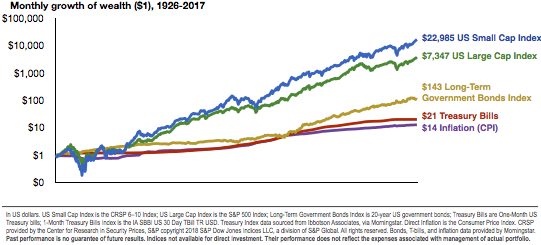Capital Markets Work
Most look to the financial markets as their main investment avenue—and the good news is that the capital markets have rewarded long-term investors. The markets represent capitalism at work in the economy—and historically, free markets have provided a long-term return that has offset inflation.
This is documented in the growth of wealth graph, which shows monthly performance of various indices and inflation since 1926. These indices represent different asset categories of the financial markets, such as stocks and bonds.
The graph of capital market growth is worth the proverbial thousand words. $1 invested in the US Large Cap Index (S&P 500) at the start of 1926 was worth $7,347 ninety-one years later.
Amazing!
Yet the US Small Cap Index’s growth to $22,985 more than tripled that of the US Large Cap Index. It grew 160 times the growth of the Long-Term Government Bonds Index, over 1,094 times Treasury Bills, and 1,641 times Inflation.

A Smarter Way To Maximize Market Returns
Traditional investment managers strive to beat the market by taking advantage of pricing “mistakes” and attempting to predict the future. Too often, this proves costly and futile. Predictions go awry and managers miss the strong returns that markets provide by holding the wrong securities at the wrong time—missing those market returns. Meanwhile, capital markets thrive—not because markets fail but because they succeed.
There is a smarter way to ensure that long-term investors will succeed in realizing market returns—a way that puts the odds of success in the investor’s favor. It’s built on what academic research has revealed about markets and investing over the past 60 years. It can be called financial science.
Financial science is based on time-tested research into financial markets, asset pricing, expected returns, and trading. It’s the discipline that the fund managers we use for equity positions in your portfolio employ to ensure that each asset-class fund used in the portfolio realizes its asset-class return—its market return.
